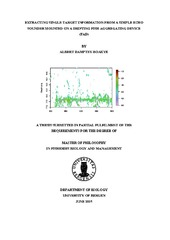Extracting single target information from a simple echo sounder mounted on a drifting fish aggregating device (FAD)
Master thesis
Permanent lenke
http://hdl.handle.net/1956/10395Utgivelsesdato
2015-06-29Metadata
Vis full innførselSamlinger
Sammendrag
Fish aggregating devices (FADs) are widely used by purse seiners in the tropical tuna fisheries. Many species of fish including juvenile tuna often associate with these FADS. There are global decline in tuna catch largely owing to the mortality of juvenile tuna often caught as bycatch. Therefore a direct method for sizing the fish prior to catching will be valuable information to mitigate juvenile fish mortality. Target strength is an indicator for how large the target is, as it is determined by the acoustic reflectivity of the fish. If the target possesses a swimbladder, it accounts for more than 90% of the echo energy of the target. This work sought to demonstrate the data collection capacity of simple echo sounders that can run on low power supply, and subsequently can be operated on batteries for an extended period of time. Acoustic data were collected using the SIMRAD ES10 single beam echo sounder at 200KHz and SIMRAD EK60 split beam echo sounder. Algorithms in the R statistical software were used for identifying and estimating target strength from single fish echoes. A linear relationship is assumed to exist between maximum TS of the dorsal aspect, and length of the fish in the form TSmax = a" *log10 (L) - b" (Nakken and Olsen, 1977). This is specific to a specie and frequency and has been estimated for many species at different frequencies. Therefore, using the TS - length of fish relationship, TS = 20 * log 10 (L) - 68, the lengths of fish were estimated. A way to transfer this information to the user in a reduced format is also discussed. This information may help in reducing bycatch leading to discard of non-target species and the catch of smaller sized tuna.
